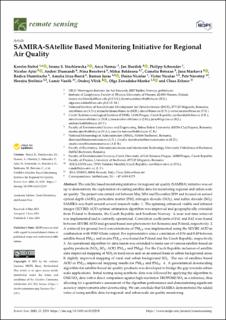| dc.contributor.author | Stebel, Kerstin | |
| dc.contributor.author | Stachlewska, Iwona S. | |
| dc.contributor.author | Nemuc, Anca | |
| dc.contributor.author | Horálek, Jan | |
| dc.contributor.author | Schneider, Philipp | |
| dc.date.accessioned | 2021-06-28T08:15:45Z | |
| dc.date.available | 2021-06-28T08:15:45Z | |
| dc.date.created | 2021-06-24T10:54:39Z | |
| dc.date.issued | 2021 | |
| dc.identifier.citation | Remote Sensing. 2021, 13, 2219. | en_US |
| dc.identifier.issn | 2072-4292 | |
| dc.identifier.uri | https://hdl.handle.net/11250/2761505 | |
| dc.description.abstract | The satellite based monitoring initiative for regional air quality (SAMIRA) initiative was set up to demonstrate the exploitation of existing satellite data for monitoring regional and urban scale air quality. The project was carried out between May 2016 and December 2019 and focused on aerosol optical depth (AOD), particulate matter (PM), nitrogen dioxide (NO2), and sulfur dioxide (SO2). SAMIRA was built around several research tasks: 1. The spinning enhanced visible and infrared imager (SEVIRI) AOD optimal estimation algorithm was improved and geographically extended from Poland to Romania, the Czech Republic and Southern Norway. A near real-time retrieval was implemented and is currently operational. Correlation coefficients of 0.61 and 0.62 were found between SEVIRI AOD and ground-based sun-photometer for Romania and Poland, respectively. 2. A retrieval for ground-level concentrations of PM2.5 was implemented using the SEVIRI AOD in combination with WRF-Chem output. For representative sites a correlation of 0.56 and 0.49 between satellite-based PM2.5 and in situ PM2.5 was found for Poland and the Czech Republic, respectively. 3. An operational algorithm for data fusion was extended to make use of various satellite-based air quality products (NO2, SO2, AOD, PM2.5 and PM10). For the Czech Republic inclusion of satellite data improved mapping of NO2 in rural areas and on an annual basis in urban background areas. It slightly improved mapping of rural and urban background SO2. The use of satellites based AOD or PM2.5 improved mapping results for PM2.5 and PM10. 4. A geostatistical downscaling algorithm for satellite-based air quality products was developed to bridge the gap towards urban-scale applications. Initial testing using synthetic data was followed by applying the algorithm to OMI NO2 data with a direct comparison against high-resolution TROPOMI NO2 as a reference, thus allowing for a quantitative assessment of the algorithm performance and demonstrating significant accuracy improvements after downscaling. We can conclude that SAMIRA demonstrated the added value of using satellite data for regional- and urban-scale air quality monitoring. | en_US |
| dc.language.iso | eng | en_US |
| dc.rights | Navngivelse 4.0 Internasjonal | * |
| dc.rights.uri | http://creativecommons.org/licenses/by/4.0/deed.no | * |
| dc.title | SAMIRA-SAtellite Based Monitoring Initiative for Regional Air Quality | en_US |
| dc.type | Peer reviewed | en_US |
| dc.type | Journal article | en_US |
| dc.description.version | publishedVersion | en_US |
| dc.rights.holder | © 2021 by the authors. Licensee MDPI, Basel, Switzerland. | en_US |
| dc.source.volume | 13 | en_US |
| dc.source.journal | Remote Sensing | en_US |
| dc.identifier.doi | 10.3390/rs13112219 | |
| dc.identifier.cristin | 1918102 | |
| dc.relation.project | ESA - den europeiske romfartsorganisasjonen: 4000117393/16/I-NB | en_US |
| dc.relation.project | Norsk romsenter: SAT4AQN | en_US |
| dc.source.articlenumber | 2219 | en_US |
| cristin.ispublished | true | |
| cristin.fulltext | original | |
| cristin.qualitycode | 1 | |

